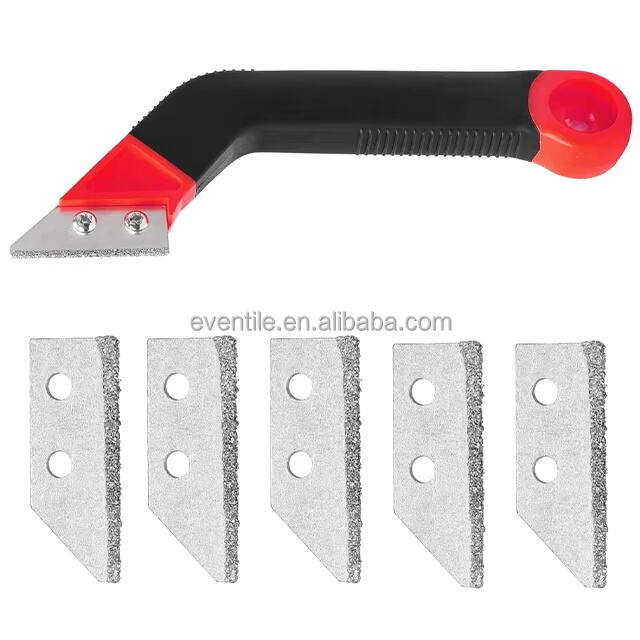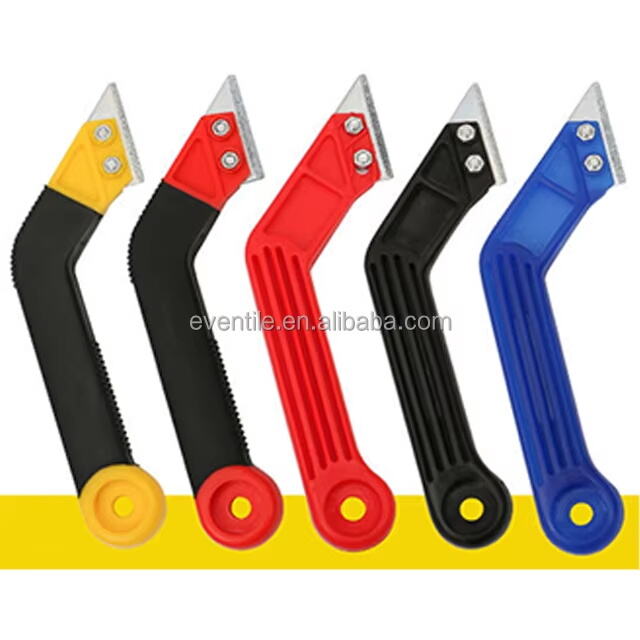Asosiy komponentlar Parket O'rnatish To'plami
Cho'zma bloklari va pull bars
Yopilma qoplamalarni o'rnatishda, uloqtirish bloklari va tortish tayasalari ishni juda osonlashtiradi. Uloqtirish bloklari yopilma doskalarini ularni shikastlamasdan ulashda yordam beradi. Bu asboblar qanchalik yaxshi ekanligi shundaki, ular har bir doskaga kuchni teng taqsimlaydi, ya'ni bir nuqtaga juda katta bosim qo'llanmasdan mustahkam ulanish hosil qilinadi. Endi tortish tayasalari haqida aytadigan bo'lsak, ular ayniqsa devorlarga qoplamalarini zich qo'shish yoki doskalar orasidagi noqulay bo'shliqlarni yopish kerak bo'lgan hollarda ishlatiladi. Tortish tayasalari yordamida o'rnatuvchilar hamma narsani shunchaki sozlashlari mumkinki, hamma izlayotgan zich tikilgan joylar hosil bo'lsin. Bu tafsilotlarga e'tibor qaratish esa butun qoplamani mustahkamlaydi, chunki hamma narsa to'g'ri joylashtiriladi va o'z o'rnida qoladi. Ko'pgina mutaxassislarning aytishicha, bu ikki asbobni birgalikda foydalanish uy-joy egalari orzulab turgan silliq va mukammal qoplamani yaratish uchun eng yaxshi natijani beradi.
To‘plam ajratuvchilari kengayish bo‘sh joylari uchun
Yangi qoplamalarni o'rnatishda etarli darajada bo'shliqlar qoldirish muhim ahamiyatga ega, chunki bu qoplamalar o'rnatilgandan keyin namlik yoki harorat o'zgarganda shkoflanish yoki to'planishni oldini oladi. Bunday bo'shliqlar qoldirilmasa, qoplamalar harorat yoki namlik o'zgarishiga javoban noto'g'ri ishlaydi. Qoplamalarning to'g'ri joylashtirilishi turli xil qoplamalarning nafas olishiga imkon beradi. Masalan, kimdir laminat yoki haqiqiy qattiq yog'och qoplamani o'rnatsa, to'g'ri turdagi kenglikni tanlash qoplamalarning moslashuvchanligi nuqtai nazaridan muhim ahamiyatga ega. Hamda teng bo'shliqlar estetik jihatdan ham yaxshiroq ko'rinadi, lekin eng muhimi bu qoplamani uzoq muddat saqlab qolishga yordam beradi. Fasllar o'tishi bilan materiallarning tabiiy ravishda siljishiga imkon berish kerak, aks holda ular bo'lishi kerak bo'lmagan joylarda kuzatiladi.
Kengayuvchi martakcha to'la sharoitda qo'llanilsa ham, parketga zarar bermaydi
Yaxshi rezina bolg'a qoplamalarni shikastlanishsiz yotqazishda katta farq yaratadi. Oddiy metall bolg'alar bu erda mos emas, chunki ular qimmatbaho yog'och yoki laminat yuzasida chiziq yoki chipta qoldirishga moyil. Rezina boshqosi ishni bajaradigan bo'lsada, yumshoq zarba beradi. Bu keyinchalik kimnidir chizilgan joylarni tuzatishga to'g'ri kelmaydigan kamroq xatoliklarga olib keladi. Rezina bolg'a tanlashda imkon qadar 16 untslik modelni tanlang. Juda yengil bo'lsa, ishni bajarishga to'g'ri kelmaydi, lekin juda og'ir bo'lsa, aslida qoplamaga shikast yetkazishi ham mumkin. Vinil teparlar, muhandislik yog'och qoplamalari yoki hatto qattiq yog'och qoplamalari bilan ishlayotgan har bir kishining qo'li ostida bo'lishi kerak bo'lgan ushbu vosita tuzilmani yaxshi moslasa, hamda yakuniy natijani yopishtirishsiz olishni kafolatlaydi. Muhim ishlab chiqaruvchilarning aksariyati mijozlar kutgan mukammal ko'rinishni yaratish uchun ishonchli rezina bolg'alarini ishlatishni maslahat beradi.
Jamoasiz Qurish uchun Asosiy Vositalar
Toʻgʻri Kirish Vositalari: Universal Pichoqlar va Qoʻzgʻiroqlar
To'g'ri kesish vositalarini tanlash, devorlarni o'rnatishda hamma narsani o'zgartiradi, chunki hech kimga doskalar orasidagi noqulay oraliqlar kerak emas. Yaxshi foydali pichoq bu erda oxirgi lahzada sozlash va kichik sozlavlar uchun deyarli kerakli vositadir. Ushbu pichoqlar vinil va laminat kabi turli xomashyolar ustida qo'l kuchi talab qilmaydigan qaytishli o'tkir pichoqlarga ega. Biroq, qattiqroq ishlarni bajarganda qurmolarda mos ravishda ishlatiladigan sifatli pichoqlarga ega bo'lishdan yaxshiroq narsa yo'q. Qalinroq taxtalarni qo'l vositalari bilan hech qanday siljiy olmagan hollarda, jigsawlar va mitra sawlar ayniqsa yaxshi natija beradi. Shuni ham aytaylikki, har bir turdagi devor qoplamasi materiali uchun mo'ljallangan sifatli pichoqlarga sarmoya kiritsangiz, katta foyda olinadi. Ular almashtirish kerak bo'lguncha uzoqroq xizmat qilishadi, shuningdek, ular tomonidan keltirilgan tozaroq kesishlar ham yaxshiroq ko'rinadi.
O'lchov chiziq va qizil chizma layout aniqligi uchun
Yaxshi o'lchov olish aslida qoplamani yaxshi bajarish yoki yomon bajarishga sabab bo'ladi, shu sababli sifatli o'lchash lentasi va bo'yoqli chiziqdan foydalanganingiz yaxshi bo'ladi. Lent o'lchov qancha material kesilishini aniqlashda yordam beradi, shunda hech qanday bo'shliqlar yoki qoplanishlar bo'lmasdan hamma narsa o'z o'rniga tushadi. Katta qismlar ustida ishlashda bo'yoqli chiziq juda qo'l keladi, chunki ular pol ustida to'g'ri chiziqlarni belgilab, narsalarni tiniq va tartiblangan holda saqlaydi. Pлитка yoki qattiq yog'och qo'yishda, shu belgilar har bir qatorni to'g'ri tekislashga yordam beradi, bu esa DIY ko'rinishi bilan professionallik hissi yaratuvchi o'rnatish o'rtasidagi farqni aniqlaydi. Yaxshi o'lchov faqat dastlabki ko'rinishda pol qanchalik chiroyli bo'lishini ko'rsatmaydi. Ular pol qanchalik uzoq xizmat qilishini ham belgilaydi, chunki yomon tekislash keyinchalik doskalar churumasiga yoki muayyan joylarda nohaq ishlashiga olib keladi.
Parket Ustida Yopishchi Bog'lovchi uchun Rollerlar
Yopishtiruvchi materiallar bilan ishlashda, qoplamalar va ularning ostki qatlamlari orasidagi mustahkam aloqani o'rnatish uchun etakchi valtslar muhim ahamiyatga ega bo'ladi. Bu valtslarning asosiy vazifasi yuzaga bosimni tekis taqsimlashdir, bu ayniqsa yelim bilan qoplamalarni o'shirishda muhim ahamiyatga ega. Agar bosim to'g'ri taqsimlanmasa, ko'pincha havo pufakchalari hosil bo'ladi yoki qoplamalar yaxshi yopishmaydigan qismlar paydo bo'ladi. To'g'ri o'lchamdagi valtsni tanlash ham katta ahamiyatga ega. Agar u juda yengil yoki noto'g'ri o'lchamga ega bo'lsa, qoplamalar to'lqinli ko'rinishga ega bo'lishi yoki yelim to'g'ri o'tmaydigan joylar paydo bo'lishi mumkin. Mos valtsni tanlash o'rnatilgan bog'lanishning qanchalik mustahkamligi va o'rnatishdan keyin natijaning qanchalik tekisligini belgilaydi. Bunday hollarda to'g'ri tanlov natijaning bardoshliligi hamda estetik ko'rinishi jihatidan yaxshiroq natijaga olib keladi.
Kirish va Kesish Muhim Korollar
Ivazli yoki Burchakli Kesimlar uchun Jigsaw
Sifatli devor qirqish zarurdir, chunki xonani to'g'ri tartibga solish uchun kerak bo'ladigan qiyin-to'g'ri yoki burchakli kesimlarni qilishda qiyinchilik tug'diradi. Ushbu arralarning devorlarni toza va mutaxassislarcha yakunlangan qilib ko'rsatishda burchaklarda, kiruvchi mebel qismlari va boshqa to'siqlar atrofida turli xil murakkab ishlarni bajarishda katta yordam beradi. Polni o'rnatish uchun devor qirqishni tanlaysizmi? O'zgaruvchan tezlik sozlamalariga ega modellar tanlang. Sozlanuvchan tezlik turli materiallarni qanday yaxshi qirqishda katta farq yaratadi. Qattiq daraxtlar sekinroq tezlikni talab qiladi, shunda esa yumshoqroq daraxtlarni yorilib ketmasdan tezroq kesish mumkin. Buni to'g'ri bajarsangiz, o'rnatish jarayonida kamroq xatoliklar va bezovta bo'lishlar bo'ladi.
Loyihangiz uchun mos puzlka topish uchun 'Puzlka' ni bosing.
To'g'ri chiziq effektivligi uchun doira qiluvchi pila
Turli xil qavat materiallarini to'g'ri chiziq bo'ylab kesishda doiraviy arralar ayniqsa yaxshi natija beradi. Bu asboblar ham aniq kesish, ham tez ishlash kerak bo'lgan hollarda samarali ishlaydi. To'g'ri turdagi disklarni tanlash, arraning ishlash sifati va uning almashtirilishigacha bo'lgan muddatini aniq belgilaydi. Kesish chuqurligini to'g'ri sozlash materiallarni tejashga yordam beradi va chiroyli, mutaxassislarga xos bo'lgan qirralarni hosil qiladi. Shu sozlamalarni to'g'ri o'rnatish qavat qilish ishlarini tezroq va chiroyli bajarishga yordam beradi.
Doiraviy pilya va qattiq variantlari haqida batafsil ma'lumot uchun Doiraviy Pilya sahifasiga murojaat qiling.
Professonal tugatish uchun chegaralarni tozalovchi asboblar
Chekka trim uskunalari hamma tomonlama qilingan devorga chiroyli ko'rinish beradi, tozaro chetlarni yaratadi va umumiy ko'rinishni yaxshilaydi. Ular devor bilan pol o'rtasidagi noqulay joylarni yopishga yordam beradi, bu esa xonaning umumiy ko'rinishini ancha yaxshilaydi. To'g'ri o'rnatilganda, bu trimlar polning oddiy ishlatish natijasida kelib chiqadigan muammolardan himoya qiladi. Ko'pincha shu turdagi barcha pol ishlarida pul sarflashga arziydi.
Edge Trim Tools haqida va uning foydalariga ko'ra, Edge Trim Tools ni tekshiring.
Ushbu kesish va chapat olish asosiyatlari laminat parket qurishda professional va traqiqsiz natija chiqarishingizni katta darajada yaxshilaydi.
Xavfsizlik va qulaylik aksessuarlari
Keng tarqalgan qurish sesionlari uchun tizma qopqalari
Yangi pol qo'shishda har bir o'rnatuvchining buyurtmalar qutisida sifatli tizzaning o'rniga ega bo'lish kerak. Ular qo'l va tizza ustida o'tkaziladigan uzun soatlar uchun haqiqiy qo'llab-quvvatlashni taklif qiladi, bu esa pol o'rnatuvchilari uchun juda ham tushunarli. Buzilishlarni oldini olish uchun tizzalarni qattiq sirtlarda ishlash paytida doimiy bosimdan himoya qilish kerak, aks holda vaqt o'tishi bilan og'riq yoki hatto jarohatlanishga olib keladi. Aqlli o'rnatuvchilar shunchaki qalin tuyg'u beradigan emas, balki haqiqatan ham yaxshi yastiqqa ega bo'lgan tizza qoplamalarini qidiradi. To'g'ri to'ldiruvchi material ishni bajara olish bilan birga, polga qon tomganini doim tekshirish o'rtasida katta farq yaratadi. Shuni ham aytish kerakki, hech kimga ish unumdorligini pasaytirishni xohlamaydi, chunki kun bo'yi ishlashdan keyin sekin-sekin yurishga to'g'ri keladi.

Himoya qushaqchalari va xavfsizlik uchun gogos
Eshiklarni o'rnatishda xavfsizlik hech qachon ikkinchi darajali masala bo'lishi mumkin emas, ya'ni qo'lqoplar va ko'zoynaklar sifatida ularning o'tkazib yuborishi mumkin bo'lgan narsalar ham ixtiyoriy emas. Qo'llar o'rnatish ishlari davomida kesuvchi qirralar, cho'tkalar, hatto elektr asboblari bilan zarba xavfi kabi turli xavflardan himoya qilinishi kerak. Shu bilan birga, xavfsizlik ko'zoynaklari ham aynan shu sababga o'z o'rnida. Ularsiz bo'lsangiz, yog'och chiplari, chang, shuningdek materiallarni kesish paytida paydo bo'ladigan boshqa narsalar kimnidir ko'ziga tushadi. To'g'ri jihozlar halokatlar sonini kamaytiradi va barchaning ish jarayoniga nisbatan xavfsizlik his-tuyg'usini mustahkamlaydi. Ishni boshlashdan oldin shu sodda narsalarni olish ham ish joyini xavfsiz va halokatlar bo'lmasligini ta'minlashda katta farq yaratadi.
Ergonomik把手lar ёкигина камайтириш учун
Qo'l uskunalari ishlatilayotganda qo'l va bilaklarda vujudga keladigan zo'riqishni kamaytirish uchun yaxshi loyihalangan qo'llab-quvvatlovchi uskunalar juda muhim o'rin tutadi. Bular ishni osonlashtiradi va natijada ish tezroq bajariladi. Qulay shakldagi qo'llab-quvvatlovchi uskunalar ishchilarga mustahkamroq ushlanish imkonini beradi va ishni aniqroq boshqarishga yordam beradi. Bu ayniqsa montaj liniyasida yoki yog'och ustalik ishlarida takrorlanuvchi vazifalarni bajarishda muhim ahamiyatga ega. Ishchilarni xavfsizlikka e'tibor qaratuvchi kompaniyalar, odatda, ish unumdorligini oshirishdi hamda xodimlarning charchash tufayli ish to'xtatishlarni kamaytirishni kuzatadilar. Ishchilar yomon loyihalangan vositalar tufayli noqulaylikka duch kelmasalar, ular ishni siliqroq bajaradilar va tafsilotlarga e'tibor qaratadilar. Kun bo'yi qo'l vositalaridan foydalanuvchilar uchun ergonomika faqatgina qimmatga tushmaydigan, balki zarur bo'lgan sarmoyadir, chunki u jarohatlarni kamaytirish va turli korxona muhitlarida umumiy ish unumdorligini oshirish orqali o'z natijasini beradi.
Parket o'rnatish cheklisti
Har bir o'z-o'zini ishlatuvchi uchun majburiy asboblar
Barcha zarur vositalarni o'z vaqtida tayyorlab qo'yish, ko'pincha o'z-o'ziga pol qoplamasini o'rnashtirish ishlarini muvaffaqiyatli yakunlash yoki muvaffaqiyatsizlikka uchrashiga sabab bo'ladi. Eng asosiy vositalarga kesish uchun arra, o'lchash asboblari, hamda hamma narsani to'g'ri joylashtirish uchun kerak bo'ladigan kichik plastmassa kengaytirgichlar kiradi. Ishni boshlashdan avval talab qilinadigan narsalar ro'yxatini tuzish, keyinroq qiyinchiliklarni oldini oladi, chunki hech kim o'rtog'ida muhim narsa yetishmayotgani haqida o'ylab qolmoqchi emas. Vositalarni oldindan tartibga keltirish ham ishni ancha silliq bajarishini ta'minlaydi, chunki kimdir unutib qolgan narsani olib kelish uchun orqaga qaytishga to'g'ri kelmaydi. Ko'pincha dam olish kunlarida ishlar bilan shug'ullanuvchilarning o'zlariga ishonch hissi o'sadi, chunki ular kerakli jihozlarni to'plashda o'zlarini mustahkam his qiladi, hatto tajriba egalariga ham katta ishlarda maxsus vositalardan birini yoki ikkitasini unutib qolishlari mumkin.
Murakkab loyiha uchun ixtiyoriy qo'shimchalr
Murakkab parket ishlari bilan shug'ullanayotgan odamlar, ko'pincha, qo'shimcha vositalar ishni ancha yaxshilaydi. Ba'zi hollarda yaxshi natijaga erishish uchun routerni yoki maxsus kesish uskunalarni qo'llash talab qilinadi. Shu qo'shimcha vositalarga ega bo'lish ish sifatini yaxshilaydi, garchi ba'zi odamlar to'g'ri bajarilganda ularning poli qanchalik yaxshi ko'rinayotganini unutib ketadi. Biroq, barcha ushbu jihozlarga mablag' ketirishdan oldin nima qilish kerakligini hisobga oling. Qanday turdagi pol qo'yilayotganini aniqlash esa qimmat vositalarga mablag' sarflash foydali bo'ladimi yoki yo'qmi, shu bilan birga uskunalar garajda chang to'playotganini bilishga yordam beradi.
Asbobning davomiyligi uchun xulosa
Uzoq muddatli o'zgarishlarni uzun muddatli uskunalarni o'z ichiga olgan holda, to'g'ri ta'mirlash narsalari ularni xavfsiz va samarali ishlashini ta'minlaydi. Biz muntazam ravishda mos yechimlar va to'plamlar yordamida asboblarni tozalashni amalga oshirsak, ularni boshqacha bo'lishidan ancha uzoqroq xizmat qiladi. Bu usulda asboblar yaxshi holatda saqlanadi. Jihozlarni tekshirish va ta'mirlashni odat qilish kunlik ishlarning yaxshiroq natijasini beradi va ishni to'xtatib qo'yuvchi noqulay ishlari qilishdan saqlaydi. Asosiy natija oddiy matematikadir. Yaxshi ta'mirlash narsalarni tez-tez almashtirish zaruratini kamaytiradi, bu esa oxirida pul tejaydi. Shuningdek, hech kim ishni to'g'ri bajarishga harakat qilayotganda nosoz yordamchi jihozlarga duch kelishni xohlamaydi.
Savollar boʻlimi
Qanday paydalilar solishtirish kompluksining asosiy komponentlari sifatida hisoblanadi?
Asosiy komponentlar quyidagilardan iborat: tapping bloklar, pull bars, solishtirish ajralgichlari, guma mallyk, toqirqulak kabi dastlabki kesish asboblari va piltalar, solishtirish rollarlari va chegaralarni tozlashingiz uchun asboblar.
Nega solishtirish ajralgichlari muhim?
Chorak ajratuvchilari, harorat va namlik o'zgarishlariga qarab chorakning shakllanishi va uzun davom etishi uchun kerakli kengayish bo'shligini saqlashga yordam beradi.
Chorak o'rnatish jarayonida qanday xavfsizlik qo'shimchalari muhim?
Muhim xavfsizlik qo'shimchalari orasida qo'llar tomonidan qo'llab-quvvatlanadigan tirsaklar, kesishuvdan va charchaqdan himoya qiluvchi himoyali quloqcha va qozonlardan himoya qiluvchi xavfsizlik ochkulari kiradi.
To'g'ri kesim asboblari chorak o'rnatishda qanday foydalar ko'rsatadi?
To'g'ri kesim asboblari, masalan, universal nozh va pilyalar har bir panelni to'g'ri ravishda moslashtirishga imkon beradi, bu esa chorakning yakuniy holati va lavozimini yaxshilaydi.


